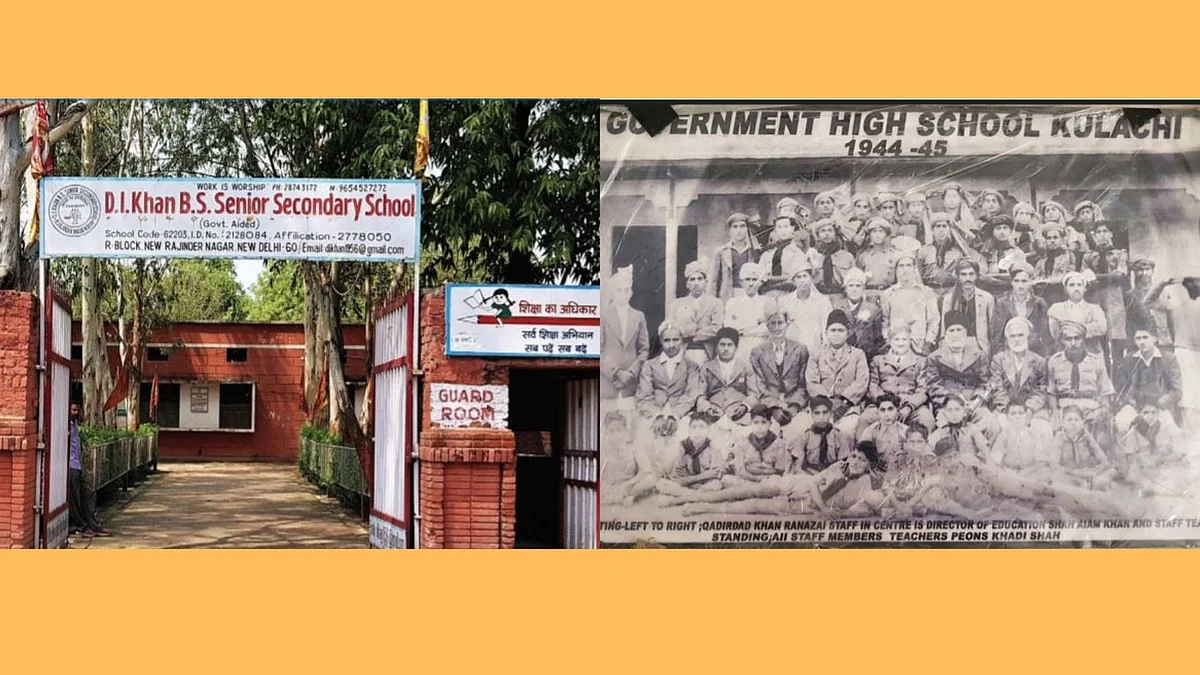A school in Delhi named after Dera Ismail Khan in Pakistan keeps memories alive
In this second part of his blogpost, London based Pakistani Chartered Accountant Shueyb Gandapur recalls the elation he felt at spotting a relative in a photograph hung on a wall in the school

Continuing on my investigation, I went to visit the school whose name had first alerted me to the existence of a Derawal community in Delhi: D. I. Khan Bharatri Sabha Senior Secondary School in Rajinder Nagar.
I was received very warmly by the manager of the school, Mr. Vijay Kumar Taneja, whom I had contacted in advance. Hailing from the Kulachi tehsil (my ancestral village) of Dera Ismail Khan district. Mr. Taneja knew about my Pashtun clan of Gandapurs very well. He gave me a tour of the school. I saw plaques of various people from the community who had contributed to the establishment and running of the school. Each plaque had “of D. I. Khan” inscribed on it beneath the name of the person it commemorated.
The school was established in mid-1950s. Its logo included the Sanskrit text “Tamaso Ma Jyotir Gamaya”. The school’s principal told me that it was a prayer from Upanishads meaning, “Lead us from darkness to light”. I was reminded of the Quranic verse “Min az zulumaati il an noor” (From darkness to light) that was part of the logo of a school I had attended in Pakistan. The message in the prayers and their placement was totally identical.
After completing the tour of his school, Mr. Taneja drove me to the second school run by D. I. Khan community, called Sati Kewal (SKR) Ram Public School, named after a 17th century Hindu saint who had established his base in a village of Dera.
The school compound included a small temple. At the base of a tree outside the temple, a sign read that the sapling for it had been brought from Sati Kewal Ram’s original temple in Bilot. Mr. Arjun Kumar Arora, the chairman of the school, related the story of the sapling’s journey. It was brought to Delhi from Dera with the help of Sikh pilgrims who had gone to visit their holy sites in Pakistan.
Inside the chairman’s office, a faded black and white group photo hung on the wall. The title read ‘Government High School Kulachi - 1944-45’. Was it a picture of my forefathers and their playmates? Looking like a graduation photo, with senior management and guests sitting on chairs in the front row, some students squatting on the ground, two of them reclining on their elbows in opposite direction to create a symmetrical formation, and several turbaned gents standing in back rows.
I recognised the name and title of my great grand-uncle at the bottom of the photo: Shah Alam Khan, Director of Education, perhaps invited as a guest to the graduation ceremony. There I was, spellbound at having found a picture of my kin in the unlikeliest of places! It seemed like seven decades of estrangement had evaporated and I was present among my own people.
Mr. Arora was busy giving instructions to his staff. At his desk, I found an issue of a fortnightly magazine called “Sati Kewal Ram Hind Sandesh”. Seemingly a newsmagazine covering local events, news and community reports, it had content in English, Hindi and one page in Urdu.
I asked for the archives of the magazine’s old issues. A box was brought and placed on the table with bound issues from the 1970s and 1980s. A gradual decline in Urdu content over the decades was noticeable. Whereas Urdu text dominated most of the pages in the old issues, it was now relegated to a single page in the new issues, usually containing a poem. A reflection of the decline of Urdu’s status from a language of correspondence, law and commerce to one good for poetic expression only.
Casually turning the pages of an old issue, I came across a marvellous find: A letter in Urdu from a well-known late elder of the Gandapur clan, former chief minister of Khyber-Pakhtunkhwa, Inayatullah Khan Gandapur, addressed to his childhood pal, Lala Takhat Ram, one of the founders of the educational institutions established by the Derawal community in Delhi.
It was a letter sent by one long lost friend to another, via a visitor from India, to establish contact after more than three decades. The author of the letter wrote about the deaths in his family and sent his condolences over the latter’s family members, the news of whose death had reached him. Published in the December 1982 issue of the magazine, it was a beautiful short memo, holding a lot of tenderness, goodwill and nostalgia. Inayatullah Khan Gandapur wrote:
“My heart yearns for meeting you again. We pray to Almighty Allah to always keep you happy and healthy. If you meet an old friend or a brother from Kulachi, please embrace him on my behalf, pay my regards and convey my love. In the current circumstances, saying more than that can result in difficulties for both you and us. I believe that the sentiments of love and friendship we hold for you and others who had to leave their homes here (during Partition) are reciprocated by you in equal measure. In these times, nothing else seems possible except exchanging prayers and best wishes for each other. If fate had a reunion in store for us, we will chat freely to our hearts’ content.”
I turned the pages and found this Urdu couplet in another article: “Ay Zauq kisi dost-e-deireena se milna / Behtar mulaqaat e maseeha o khizr se” (Reunion with a friend from old times is a treat / Better than meetings with messiahs and saints).
The two gentlemen, however, passed away before fate could provide the occasion for a reunion.
Follow us on: Facebook, Twitter, Google News, Instagram
Join our official telegram channel (@nationalherald) and stay updated with the latest headlines
